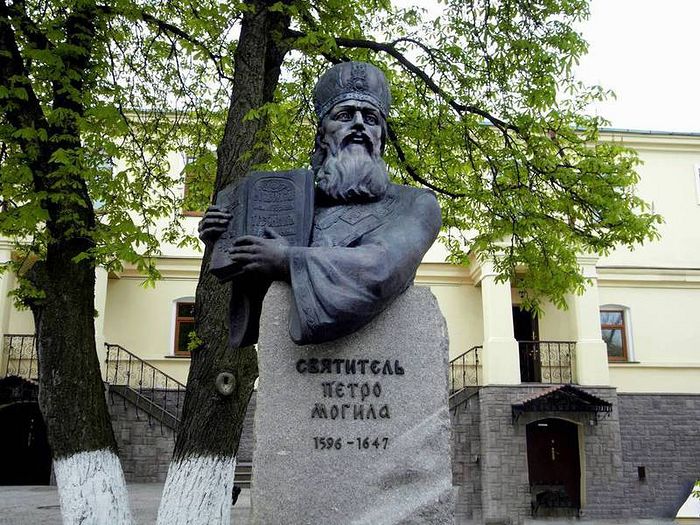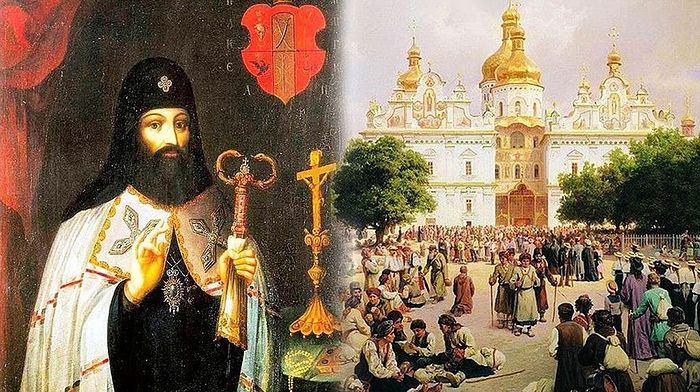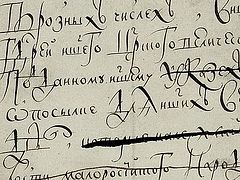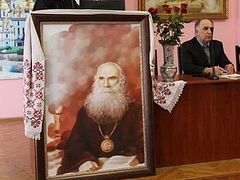 The monument to the Holy Hierarch Peter Mohyla outside the Kiev Theological Academy. Photo: np.pl.ua
The monument to the Holy Hierarch Peter Mohyla outside the Kiev Theological Academy. Photo: np.pl.ua
Introduction by Matfey Shaheen:
“The name of Peter Mohyla is one of the greatest adornments of our church history.”1 That is how Metropolitan Macarius (Bulgakov), one of the most acclaimed Russian Church historians, summarized the importance of the Holy Hierarch St. Peter Mohyla (also spelled Mohyla and Movilă), not speaking only for the Russian Church, but for the entire Eastern Orthodox Church.
St. Peter Mohyla is not only credited with literally saving Orthodoxy in the territory of what is now modern-Ukraine, Belarus, and Lithuania, (the Polish-Lithuanian Commonwealth) but also with establishing the first Orthodox seminary, and one of the oldest printing presses. He is also a very powerful patron and role-model for anyone working in Orthodox education and publication, as he pioneered the implementation of new technologies and scientific techniques in these fields to strengthen the Church in a world seeking her destruction.
His good works shined forth in his days, rendering the Church of all Rus’ great service, and earned him the heavenly crown of sainthood. Regardless of his Moldovan ancestry, many great Russians, such as the St. Petersburg scholar Alexander Vostokov, would go on with gratitude to say that he was: “more Russian than any Russian.”
Despite his historical acclaim, there was a certain movement in Russian theological thought of the late nineteenth and early twentieth century, which, in their admirable pursuit for the purity of Orthodoxy from heterodox errors, would begin to revise their view on St. Peter, and view him and the Kievan Baroque-era school of theology with suspicion.
This is an article from the Rector of the Kiev Theological Academy, and therefore, in a way, a successor to Peter Mohyla—Bishop Sylvester (Stoychev) of Belgorod. Last year, after a meeting that took place around the name day of Metropolitan Onuphry of Kiev, Vladyka Sylvester presented me with this article,2 which he had published in 2012, in the 17th edition of the journal, “Works of Kiev Theological Academy”, which is now available online. He also presented me with a copy of his recently published Ukrainian language dogmatic theology textbook “Догматичне богослов'я”3, which is one of the finest available in that language. Vladyka Sylvester highly venerates St. Peter and admirably cares for the school he founded. Bishop Sylvester is one of the brightest theological minds in the Ukrainian Orthodox Church, and his article on St. Peter Mohyla is very valuable to any student of the history of Orthodox Theology and education.
On the question of western influence in the Theological heritage of the Holy Hierarch Peter Mohyla
Metropolitan Peter Mohyla can without exaggeration be called the man of his epoch. During his short life, he managed to achieve several things, each of which became foundational for development in centuries to come. His most important work was certainly his comprehensive support for theological studies. To this end, the Holy Hierarch reformed the Kiev Brotherhood School, published works of theological and polemic character, and gave order to liturgical practice.
However, the assessments of the activities of Metropolitan Peter, and especially his theological heritage remains controversial. Since the end of the nineteenth century, with an easy hand, fighters for the “liberation” of Russian theology4 began to scrutinize Metropolitan Peter Mohyla, despite his large-scale services, as “guilty” for the infiltration of alien, scholastic ideas in Orthodox Theology; in theological schools, his name became steadily associated with what is commonly called “Western influence” or even “[the] Western captivity [of Russian theology]”.
Russian-language theological and church-historical literature dedicated to Metropolitan Peter Mohyla is extremely extensive. Therefore, here we will pay attention only to the most well-known publications. Most authors, recognizing the fact that Russian theologians became acquainted with Western scholasticism even before St. Peter Mohyla, are nevertheless still inclined to see in the activity of the Kievan Metropolitan the beginning of not just [Western] influence, but of “Western expansion or captivity”. We should mention here the names of Hieromonk Tarasiy (Kurgansky), Archbishop Vasily (Krivoshein), and especially Archpriest Georges Florovsky. The latter, speaking on western influence in his famous work Ways of Russian Theology, writes: “It would be unfair to place all blame for this on Mohyla. The process of "Latinization" began long before he came on the scene. He was less the pioneer of a new path than an articulator of his time. Yet Peter Mohyla contributed more than any other, as organizer, educator, liturgical reformer, and inspirer of the Orthodox Confession, to the entrenchment of "crypto-Romanism" in the life of the West Russian Church.”56
The indicated authors and their epigones substantiate their assertions by reference to the fact that Metropolitan Peter firstly created in Kiev a school on the model of the Jesuit [schools]; and secondly, is the author of a text [The Orthodox Confession of the Catholic and Apostolic Eastern Church] containing explicit parallels with Latin teaching. Let us consider these charges.
For the Kievan Metropolia, as is known, the period and boundaries of the sixteenth and seventeenth century constituted a difficult time. Orthodoxy was in unfavorable political, economic, and cultural conditions. The Orthodox Church was not the only Christian denomination, nor the dominant or most educated in the Polish-Lithuanian Commonwealth. While the Protestants had strong patrons among the Polish Szlachta7, and the Jesuits achieved incredible fortunes in the educational process, the Orthodox were deprived of all of this. In such a view, Metropolitan Peter faced several strategic tasks, and the transformation of the educational process is one of them.
At that time, the Jesuit colleges, being the best of their kind, also performed the function of training polemicists. This explains why St. Peter took them as a model when he decided to reorder the school affairs in Kiev. Father Georges Florovsky evaluates the decision of the Metropolitan extremely negatively: “His school was a Latin school—Latin not only in terms of language, routine, or theology, no, Latin in all religious psychology: the souls of the students were Latinized. External independence was retained, but internal independence was lost. Eastern ties were interrupted. The essence of this pseudomorphosis, is in that scholasticism overshadowed and replaced patristics in Russia.”8
In this passage, it’s worth paying attention to several key accusations (all critics repeat them to one degree or another): 1) the Latinization of the educational process, 2) the interruption of eastern ties, 3) the replacement of patristics by scholasticism.
As already noted, the Metropolitan was faced with the task of elevating the school to the necessary level. It is completely natural in such cases, to take an example from those schools which have reached such a level. The Holy Hierarch Peter Mohyla took the path known prior to him, and used hundreds of times after him: he adopted the most fruitful, from that which was available.
A fair question arises: was there a choice? Could the Metropolitan of Kiev have taken a different, non-Latin school, as a model? In the arguments of such an informed historian as Father Georges Florovsky, it is simply surprising that while rebuking Peter Mohyla, he acts as if he is not aware of the general condition of Orthodox education during that time period, or simply ignores the fact that Greeks who wanted to receive an education headed to the West, and that all famous Greek theologians of that time studied at Western universities, usually in Italy. A few decades after the death of Metropolitan Peter, Patriarch Dositheus of Jerusalem in his correspondence with the Tsar of Moscow, Alexy Mikhailovich, will point out the issue of the lack of educational institutions among the Greeks, and express regret that Greek youths must go to the West.
To believe that Metropolitan Peter could have solved this problem by taking other, non-Western schools, as a model, is simply anti-historical.
Professor of Kiev Theological Academy Stefan Timofeevich Golubev, in his fundamental work on Metropolitan Peter Mohyla, draws attention to the fact that subjects were being covered only partially in Pre-Mohyla epoch schools. The Metropolitan of Kiev’s creation of a new model of school not only filled these gaps, but also removed the need for Orthodox youths to seek education exclusively in the West!9
In this way, the creation of [Mohyla’s] school was the most important culture-forming phenomenon that saved the Orthodox people from even greater Western influence that could have been.
Florovsky’s claim about the interruption of eastern connections is, generally speaking, difficult to understand. Concerning which connections are we discussing? Cultural ties in the fullest sense could not be developed, not only under Peter Mohyla, but before his time, due to the tragic events of 1453.10 Education and theological studies were seriously damaged by the actions of Patriarch [of Constantinople] Cyril I Lucaris, however Peter Mohyla never interrupted the connections with the eastern hierarchy.
We now return to the claim of the replacement of patristics with scholasticism. In this case, Florovsky’s thought is again, not clear. If he speaks of interest in the Fathers, in the reading of their works, then there is nothing to blame the Kievan transformer and his school for. The historian of education, and author of several works in this field, Konstantin Kharlampovich, in his study “The Struggle of School Influences in Pre-Petrine Rus’”1112, cites the fact that in 1632, Metropolitan Peter purchased books for the library in Warsaw and Lvov. Of the eighty-six titles purchased, the vast majority were the works of the Holy Fathers.
The same author draws attention to the fact that a little later, teacher of the Mohyla Collegium Archimandrite Ioannikiy Halyatovsky, giving recommendations to students on where to look for materials for sermons, advised: “Read the Bible and the Holy Fathers: Sts. Basil the Great, Gregory the Theologian, John Chrysostom, Athanasius, Theodoret, Ambrose, [John of] Damascus.” In this way, within Mohyla’s schools, the patristic heritage was included into the educational process; the Holy Fathers were recommended reading, their creations were purchased for the library. Let us recall that for a number of objective reasons, the publication of patristic heritage became possible specifically in the West.
It’s inferred from the words of Father Georges Florovsky, that he suggests that before Metropolitan Peter Mohyla, there were patristics, which were replaced by scholasticism due to his school reform, but here, again, it’s not entirely clear what he means by “patristics” in the pre-Mohyla epoch; perhaps he is referring to a style of thought?
Florovsky himself may be alluding to this, when he speaks of the “Latinization” of the souls of the students. But this claim of Father Georges is not supported by any serious research or citations, and therefore it sounds unconvincing.
There was, of course, a western influence on the educational process in the Mohyla Collegium, and this much cannot be objectively denied, but it should not be exaggerated, let alone absolutized. Even such a critic of Kievan theology as Hieromonk Tarasiy, who calls the scholastic method mechanical, soulless, and artificial, nevertheless remarks: “One must admit that the system borrowed from the Latin scholastics, in its integrity and completeness, surpasses the ancient patristic systems [which were] completely or partially very dependent on the contextual circumstances of their era, and reflecting the spiritual needs of their time, while the scholastic system presents something unchanging and constant.”
It is quite obvious that for solving educational issues (at least at some stages), the scholastic form is very convenient. And often the process of a teaching system covering a wide-range of material, invariably begins to bear signs of a scholastic method, of some form of artificiality.
The Mohyla Collegium had to solve the issues of its time, and it achieved this quite successfully. The activity of St. Peter on the basis of education gave impetus to an intellectual breakthrough and the expansion of the number of theologically educated people. Undoubtedly, this is the greatest merit of his, and the school created by him.
Now we turn to the more complex issue of the borrowing of scholastic formulations and theological ideas by Metropolitan Peter.
The main document to be examined in this case, is “The Orthodox Confession of the Catholic and Apostolic Eastern Church”13 written by Metropolitan Peter. One of the critics of western influence, Archbishop Vasily (Krivoshein), calls this text “the most ‘Latin-wise’ document among the symbolic monuments of the 17th century.”14 Similar assessments are given by other authors; that view simply migrated from book to book, textbook to textbook. A lamentable story happened with The Orthodox Confession: Almost no one actually reads it, yet at the same time, everyone apparently knows that it is under the strong influence of Western scholasticism.
A bit of history: The Holy Hierarch Peter Mohyla, as is known, wrote the text of The Orthodox Confession and submitted it for judgment to the Council in Kiev, and then in Iași; the text of Confession underwent amendment. The chief redactor was [the Patriarchal Protosyncellus of Constantinople—Trans.] Meletios Syrigos1516, who, among other things, was the translator of Confession from Latin into Greek.
In Kiev, the Metropolitan published a text with corrections made by Syrigos. Father Georges Florovsky offers the following motivation for the acts of the Hierarch: he did not agree with the changes made to the text; instead of the edited text, he published in 1645 the “Small Catechism”, which contains numerous Latin misconceptions. Thus, the opinion that St. Peter Mohyla deliberately published the text without the corrections, simply ignoring them, also became commonplace in most publications about him.
It is not clear what inspired Florovsky to make such an unflattering conclusion concerning the Metropolitan of Kiev. Some researchers who wrote about Mohyla and his Confession saw other reasons for the appearance of the 1645 edition. It follows to reference the publications of A. Volhovsky17, Archpriest A. Gorsky18, and S.D. Rozhdestvensky19.
These authors believe that the reason St. Peter was prompted to publish his [unedited] work was the delay in the preparation of the redacted text by the Greeks. The Metropolitan waited around three years, and having still not received the edited text, he published the unedited text. There is no evidence confirming the opinion of Florovsky, that the reason for the publication of the unredacted text was due to the disagreement of St. Peter with the given corrections.
It is imperative to remember that the situation at that time was quite critical. Latin and Uniate propaganda on the one hand accused the Orthodox of not knowing their faith, (Gorsky quotes the words of the renegade Fyodor Skumnovich: “The Russians on the simplest questions concerning the dogmas of faith do not have firm answers.”20), and on the other hand, [accused them of] condoning Protestantism.
The Holy Hierarch Peter himself, in the foreword to the publication, points to the lack of [available Orthodox printed] literature, and to slander from the Poles “that priests don’t know the Faith.” Thus, it can be seen that the reason for the appearance of the 1645 edition was of a strictly educational character.
Regarding the content of the Orthodox Confession, and the scholastic inclusions contained within it, Florovsky draws a sharp conclusion: “Mohyla never voiced doctrinal objections to Rome. In dogma, he was privately, so to speak, already at one with the Holy See.”21
It is perfectly clear however, that Metropolitan Peter does not profess the traditionally most significant Latin errors, from the perspective of Orthodox-Catholic polemics, such as the Filioque and the doctrine of the supremacy of the Bishop of Rome.
Nevertheless, critics of his theology give other examples of scholastic borrowings, namely: 1) the scholastic method of presentation and 2) the theological teaching itself.
Before proceeding to consider these charges, Peter Mohyla’s critics never conducted a serious scientific study of the influence of Western scholasticism on his writings. In this way erred all who criticized the actions of Metropolitan Peter, and/or Kievan theology as a whole: both Archpriest Georges Florovsky, and Archbishop Hilarion (Troitsky), and Hieromonk Tarasy (Kurganovsky).
In the best case, there should be a comparison of the ideas in question—the spirit and spirituality of Eastern Theology and Western scholasticism, like for example in the works of Father Tarasy, but usually, these authors simply set forth their own impression of what they’ve read, and nothing more. No comparative analysis of the texts or a search for any of the sources of the ideas in question are carried out—in any case, not in the given publications.
This task, however, has been undertaken now by modern scholars, free from biased ideological battle-cries in the context of this “war of liberation in theology”. Among them are historians, cultural experts, and philologists. We would like to draw attention to the publications of Margarita Korzo on the catechisms written between the 16th and 18th centuries.22 In the context of this essay, the most relevant work of interest is her article specifically dedicated “[to the] Orthodox Confession of Faith”.23
This is practically the only work in the Russian language, in which a detailed comparison of Latin catechisms, and Peter Mohyla’s Confession,24 is more or less made. Having taken several different editions of the Confession, she compares them with the so-called “Roman Catechism”, which was most commonly proliferated at that time.
A comparison of the texts shows that Peter Mohyla used the principles of exposition characteristic for Latin catechisms,25 and distributed the material in accordance with the three so-called “Theological Virtues”—Faith, Hope, and Love.26
The first section (Faith) is devoted to the presentation of the Symbol of Faith [the Creed27] the church commandments28 and sacraments, the second section is dedicated to prayer—the Our Father, the Beatitudes from the gospel, and the third section, to virtues and sins, and ends with the exposition of the Decalogue [the Ten Commandments]. For the sake of fairness, it is necessary to clarify that such a system [of presentation] was already proposed by the Blessed Augustine of Hippo in his Enchiridion to Laurentius on Faith, Hope, and Love. Therefore, this style of exposition and distribution of material has a rather ancient origin.
If we speak about specific theological categories of phenomenological understanding, then first of all, it should be noted that in the Confession, we encounter the concept of “original sin”.2930 According to M. Korzo, this testifies to a “western influence in the theological constructions of the Kievan Metropolitan.”31 Indeed, this term doesn’t exist among the eastern Fathers, they preferred other definitions.32
It is important to note, however, that [despite] the similarity of terms, there is often a different theological understanding. Many examples from church history can be cited. Remember that when the term “original sin” firmly entered the theological language in Russia, it was used by theologians of various directions. Original sin is in many ways a useful term. It can be used in different contexts, and its use, in and of itself, by no means carries exclusively Latin connotations.
In the case of Confession, this is exactly so: St. Peter Mohyla clearly did not accept the Western understanding of the term “original sin”. Concerning this, M. Korzo notes: “An important difference between the text of Mohyla and the “Roman Catechism” is the frequency of use of this concept.33 If in the first case [of Mohyla’s catechism] we can only talk about it being used one time, then in the “Roman Catechism” a detailed examination of the essence of original sin, and the method of its transmission from Adam is given in thirteen articles. Moreover in [the Roman Catechism], the concept of “original sin” is the key in anthropological [ontological] constructions, which is completely not characteristic of Mohyla’s catechism.34 Then Korzo, citing many excerpts from Confession on the relationship of freedom and grace, summarizes: “These views are so contrary to the Catholic ideas about the state of human freedom and will, after the fall, that they allow us to justifiable say, that if the Kievan Metropolitan, borrowing a few concepts of Catholic anthropology, would have fully embraced the doctrine of the fall and its consequences, that for a section on free-will there would be no place in the Orthodox Confession of Faith.”35
Regarding sacramentology, according to M. Korzo, this can be considered the part of Metropolitan Peter’s doctrine under the most Latin influence. Analogous to the Latin catechisms, he introduces concepts such as matter and form into the teachings concerning the sacraments. The same division later takes place in his Trebnik. Latin influence also explains the opinion of Peter Mohyla about the possibility of baptism by affusion, the use of the term "transubstantiation", and the statement about the time of the completion of the sacrament of the Eucharist with the words of the anamnesis.
Nevertheless, it is necessary to clarify that the question of the exact moment of the offering [i.e. transubstantiation/Metousiosis] of the Holy Gifts has for a very long time, occupied the minds of Russian theologians, and was resolved only at the Council of Moscow in 1690, that is to say, almost 50 years after the death of Peter Mohyla. The use of the term transubstantiation, as Protopriest Valentin Asmus notes, “began according to the example of Catholic theology. But this is just a terminological borrowing. One could speak of theological influence only if the whole Aristotelian metaphysics was explicitly assimilated, with the doctrine of substance, accident, etc., which in scholasticism comes along with the term transsubstantiatio. In the works of St. Peter (Mohyla), this term “transubstantiation” is not the only term being used: the Eucharistic celebration or conduction of the mystery of the Eucharist is also called “change”, (преложение, пременение)36.37
Baptism by affusion is an abnormal phenomenon, but Peter Mohyla does not make any doctrinal arguments in favor of it, but simply considers it possible to perform the sacrament in this way. Probably for him, it was more a practical issue, rather than a doctrinal one. Historically, for a long-time, baptism by affusion was a ubiquitous practice, Metropolitan Peter neither invented it, nor did he create historical prerequisites for it.
Therefore, to summarize our short review, we note that the question of the theological views of St. Peter Mohyla, and the degree of borrowing requires rigorous study, moreover, attentive and unbiased study. As already noted, critics of the Kievan Metropolitan most often not only fail to conduct a comparative analysis, but in general don’t even burden themselves to quote from the Confession, in order to prove that which they wrote about the Holy Hierarch.
The name of Peter Mohyla became, in a concrete historical epoch, a symbol of everything bad in Russian theological education, a symbol of scholasticism and Western captivity. He was mentioned not so much in scientific works, as in incendiary sermons and accusatory speeches. However, an ironic situation arose: the denunciators of his school of theology, who saw Western influence everywhere, subsequently themselves became the object of criticism. They themselves were caught in borrowing, influence, and departure from patristic tradition.
Archbishop Vasily Krivoshein wrote: “The reactions of Russian theological thought of the late nineteenth to the beginning of the twentieth century lacked genuine knowledge of patristic tradition in its entirety, [and] a positive disclosure on its basis of the dogmas of Orthodoxy.”38 Continuing the thought of Vladika Vasily, we note that they also lacked knowledge of Latin theology. In the end, one must understand the whole diversity of Latin scholasticism, and the fact that it is not always possible to equate the medieval scholastic tradition with the official teaching of the Catholic Church.
Now publications are beginning to appear rehabilitating Metropolitan Peter Mohyla from accusations of total adherence to scholastic doctrine.39 It is obvious that reading texts through the prism of a “liberation war” suffers from aberration. Of course, it would methodologically be wrong to decide to write about Peter Mohyla in order to simply accuse him or, conversely, to completely justify. In studies on the history of Russian theology, when studying the heritage of Metropolitan Peter and his era, all clichés must be left aside.
At this stage, the study of the heritage of the Holy Hierarch Peter Mohyla, and, more specifically, Western influences in his theology, leaves more questions than answers.





